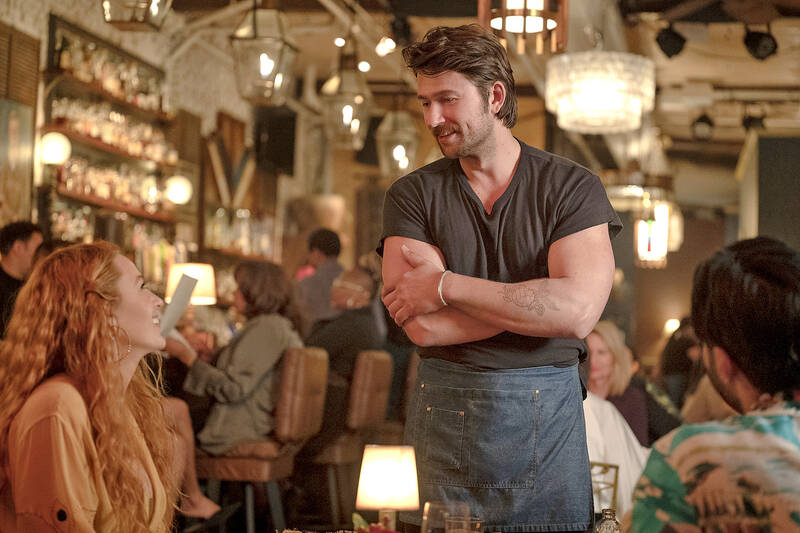Lily Bloom and Ryle Kincaid don’t really meet-cute. On a rooftop in Boston, he announces himself by angrily kicking a patio chair. She’s up there trying to come to terms with her abusive father’s death. They talk about maraschino cherries, gun violence and flirt. There’s something off about this pair. But there’s also an obvious attraction.
So begins the uneven movie adaptation of Colleen Hoover’s best-selling 2016 novel It Ends With Us starring Blake Lively, which tries to balance the realities of domestic violence inside a rom-com and a female-empowerment movie. All suffer in the process.
It veers too close to melodrama, with suicide, homelessness, generational trauma, child murder, unintended pregnancy and never-forgotten love all touched on and only half digested. Set in Boston, it never even pulls from that city’s flavor.

Photo: AP
The film centers on Lively’s Lily, a flower shop owner who finds herself in the middle of a complicated love triangle between hunky neurosurgeon Ryle — Justin Baldoni, who also directs — and her hunky high school sweetheart, Atlas, played with hangdog cuteness by Brandon Sklenar.
There are red flags about Ryle but they aren’t obvious until they’re strung together, which takes, literally, years. Credit to the filmmakers for not making the potential abuser so easy to wave a red flag about.
The most powerful thing about It Ends With Us is the after-effects of domestic violence and how they unmoor those who witness or survive it. This could have been tightened or highlighted more. (The end credits direct viewers to the anti-domestic violence group No More.)

Photo: AP
Baldoni perfectly balances menace and seduction, operating in the zone between assertive and psychotic. And his direction is good, with an ability to summarize scenes quickly and move the plot elegantly, although he does have a fondness for too many music-led montages.
Lively is fine here, veering dangerously close to Manic Pixie Dream Girl with her cute flower sketches and love of shabby chic, but perks up at the end. She wears a lot of rings and a lot of florals but can also stun a room in a cut-out dress.
The script by Christy Hall has some terrible clunkers — “This man runs through women like candy,” someone says at one point — but nicely maneuvers around the book’s weird spots, like making Lily’s dad’s funeral a flashback instead of an odd recreation on the rooftop.

Photo: AP
But It Ends With Us doesn’t end quickly enough — more than two hours drag — with tangents and poor editing, like sudden scene cuts that leave viewers looking for clues to where they are.
And we have so many questions, like how Lively’s character got onto the roof of that luxury highrise in the first place. And what’s with Lily’s best friend — Jenny Slate, clearly stealing the movie — who wears Valentino dresses and carries a purse that costs the same as a small car? She clearly doesn’t need a retail job, but works at the flower shop anyway?
And what’s with the weird relationship with Carhartt — check out the copycat logo appearing and disappearing from jackets and jumpsuits — apparently trying to show the wearers as down-to-earth working class folks, when they are not.
The movie’s adoration of wealth and luxury — from a Mercedes to million-dollar apartments and fancy dinner reservations — I guess are attempts to show that domestic violence isn’t confined to sports bars and factories.
What’s very funny is that Lily clearly has a type: Both her paramours are dark-haired buff dudes who favor tight black T-shirts, have stubble beards and adore her. When they fight — and they do — it’s actually hard to tell them apart.
The bursting soundtrack — with Thom Yorke’s Dawn Chorus, Lewis Capaldi’s Love the Hell Out of You and Brittany Howard’s I Don’t represented — has the undeniable presence of Lively bestie Taylor Swift, who has lent her My Tears Ricochet.
When Lily and Ryle finally hook up for the first time, she warns him: “Don’t let me regret this.” She will, of course. And a few others who are part of this film probably will, too.

On the final approach to Lanshan Workstation (嵐山工作站), logging trains crossed one last gully over a dramatic double bridge, taking the left line to enter the locomotive shed or the right line to continue straight through, heading deeper into the Central Mountains. Today, hikers have to scramble down a steep slope into this gully and pass underneath the rails, still hanging eerily in the air even after the bridge’s supports collapsed long ago. It is the final — but not the most dangerous — challenge of a tough two-day hike in. Back when logging was still underway, it was a quick,

From censoring “poisonous books” to banning “poisonous languages,” the Chinese Nationalist Party (KMT) tried hard to stamp out anything that might conflict with its agenda during its almost 40 years of martial law. To mark 228 Peace Memorial Day, which commemorates the anti-government uprising in 1947, which was violently suppressed, I visited two exhibitions detailing censorship in Taiwan: “Silenced Pages” (禁書時代) at the National 228 Memorial Museum and “Mandarin Monopoly?!” (請說國語) at the National Human Rights Museum. In both cases, the authorities framed their targets as “evils that would threaten social mores, national stability and their anti-communist cause, justifying their actions

In the run-up to World War II, Admiral Wilhelm Canaris, head of Abwehr, Nazi Germany’s military intelligence service, began to fear that Hitler would launch a war Germany could not win. Deeply disappointed by the sell-out of the Munich Agreement in 1938, Canaris conducted several clandestine operations that were aimed at getting the UK to wake up, invest in defense and actively support the nations Hitler planned to invade. For example, the “Dutch war scare” of January 1939 saw fake intelligence leaked to the British that suggested that Germany was planning to invade the Netherlands in February and acquire airfields

The launch of DeepSeek-R1 AI by Hangzhou-based High-Flyer and subsequent impact reveals a lot about the state of the People’s Republic of China (PRC) today, both good and bad. It touches on the state of Chinese technology, innovation, intellectual property theft, sanctions busting smuggling, propaganda, geopolitics and as with everything in China, the power politics of the Chinese Communist Party (CCP). PLEASING XI JINPING DeepSeek’s creation is almost certainly no accident. In 2015 CCP Secretary General Xi Jinping (習近平) launched his Made in China 2025 program intended to move China away from low-end manufacturing into an innovative technological powerhouse, with Artificial Intelligence